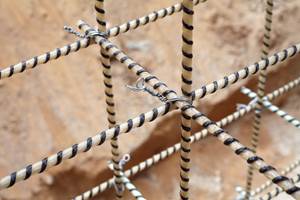From the Publisher
Introducing composites into the infrastructure and construction markets is a process fraught with complexity. Although they are capable of high performance, composites are usually adopted into new markets on the strength of their other benefits, such as corrosion resistance and weight savings. In the infrastructure
Introducing composites into the infrastructure and construction markets is a process fraught with complexity. Although they are capable of high performance, composites are usually adopted into new markets on the strength of their other benefits, such as corrosion resistance and weight savings. In the infrastructure arena, however, components almost always require truly critical structural performance as well. Delivering high-level performance requires the selection of not only strong, reliable, yet affordable materials but also a design optimized for both the part requirements and the chosen manufacturing method. If all goes well, you end up with a great part - one that will do the job and can be priced to compete. Then you get to prove it to your potential customers. Despite these challenges, composites already have made significant inroads into infrastructure. Today, prices are rising for traditional materials, and there is an ever-growing number of engineers that now recognize the unique characteristics composites can bring to a project. The greatest challenge going forward - and the key to future growth - is developing products that can meet all applicable standards.
Not only does every global geographical region and country have its own set of procedures, test methods and codes for civil structure, nearly every state and municipality does as well. Great strides are being made to standardize these requirements - there are entire governmental agencies and associations working on these issues. CT tries to keep up with new code standardization and, as part of that effort, we are happy to announce a cooperative effort with Larry Bank, author of the new book, Composites for Construction - Structural Design with FRP Materials. In every issue this year, he will write a column, partially excerpted from his book, that discusses code-based design procedures for a specific type of FRP structure - procedures that will enable engineers to ensure, at design inception, that a product will meet requirements. Bank begins this issue with composite rebar for concrete reinforcement (see “Related Content,” at left). We trust this editorial feature will be of practical use to you, our readers. We'd like to hear your opinion on it as well as anything you'd like to add.
The new year brings other good tidings, as well: After a two-year search, Composites Technology has found a new home. This month, CT becomes part of Ohio-based Gardner Publications Inc. As many of you know, our small media company of around 15 dedicated people has been devoted to providing timely, useful information about the design and manufacture of composite materials. We were around during the boom times in the 1990s and are proud to say we weathered, along with the rest of the composites industry, the tough economic times in 2002 and 2003 - founding Compositesworld.com, the industry's leading Web site, during that time.
But we have felt for some time that we could benefit greatly from an association with an anchor company that might provide the stability and resources needed to further enhance our services for our customers - readers and advertisers alike. Toward that end, Gardner, our new owner, is an ideal partner. Established in 1928 with the still-thriving trade magazine Modern Machine Shop, Gardner's current publications all focus, like CT, on the world of manufacturing. Gardner's is a multimedia business that delivers information about manufacturing technologies, suppliers and products to its readers by a variety of sophisticated means. As we go forward, that will be important to us.
While we'll be working, in the background, to integrate our products into Gardner's established systems - which we assume will be a seamless transition - there won't be any noticeable changes to the magazines, e-newsletter or Web site in the short term. In the long term? The only change you'll see will be change for the better.
We wish you and your company as great a year as we anticipate at Gardner.
Related Content
ExxonMobil announces licensing agreement to expand GFRP rebar processing tech
ExxonMobil acquires exclusive overseas licensing rights for Neuvokas’ proprietary manufacturing process, expanding to global markets.
Read MoreSGL Carbon carbon fiber enables German road bridge milestone
A 64-meter road bridge installed with carbon fiber reinforcement is said to feature a first in modern European bridge construction, in addition to reducing construction costs and CO2 emissions.
Read MoreSireg Geotech fiberglass rebar supports Italian bridge reconstruction
The ETA-certified composite rebar was applied to the bridge’s precast elements for a lightweight, longer-lasting bridge that is also more resistant to corrosive elements.
Read MoreNew standard specification supports non-metallic FRP rebar
ASTM International standard D8505 enables further integration of FRP rebar into infrastructure applications.
Read MoreRead Next
“Structured air” TPS safeguards composite structures
Powered by an 85% air/15% pure polyimide aerogel, Blueshift’s novel material system protects structures during transient thermal events from -200°C to beyond 2400°C for rockets, battery boxes and more.
Read MoreAll-recycled, needle-punched nonwoven CFRP slashes carbon footprint of Formula 2 seat
Dallara and Tenowo collaborate to produce a race-ready Formula 2 seat using recycled carbon fiber, reducing CO2 emissions by 97.5% compared to virgin materials.
Read MorePlant tour: Daher Shap’in TechCenter and composites production plant, Saint-Aignan-de-Grandlieu, France
Co-located R&D and production advance OOA thermosets, thermoplastics, welding, recycling and digital technologies for faster processing and certification of lighter, more sustainable composites.
Read More





















